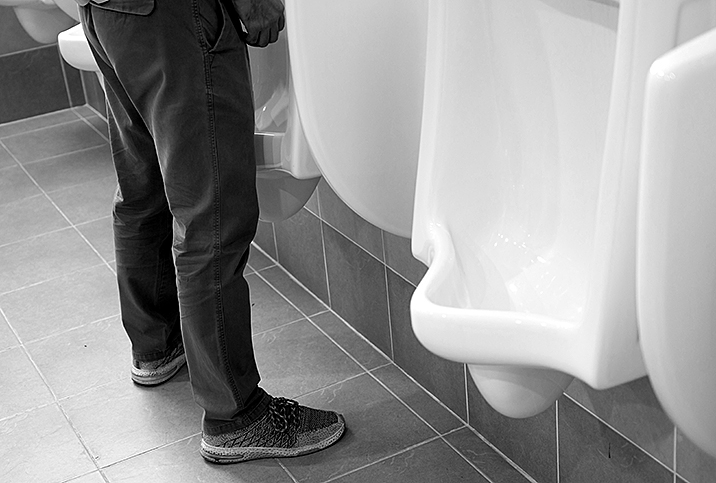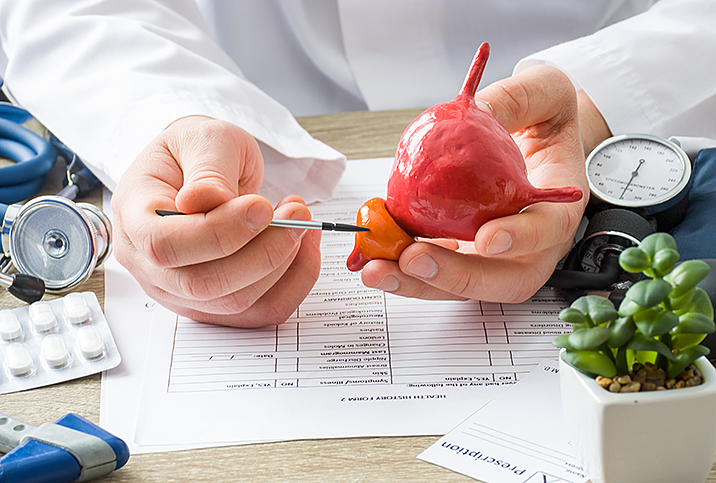Benign Prostatic Hyperplasia: Treatments and Risks

Benign prostatic hyperplasia, or BPH, is a condition caused by prostate enlargement that can put strain on the bladder and affect urine flow. It is common in older males, affecting 70 percent of U.S. men in their 60s and 80 percent of men older than 70, according to the American Urological Association. Fortunately, it is also very treatable.
Before men can get diagnosed and treated for BPH, they need to recognize the most common symptoms:
- Urinary urgency and frequency
- Difficulty initiating urination
- Frequent urination during the night (nocturia)
- Incontinence
- Urinary retention
The last symptom on the list, retention, is a huge problem because it means you can’t urinate at all. If you are in severe retention and very uncomfortable, you need to go to a nearby emergency department for evaluation. You man need a Foley catheter placement for bladder decompression.
Treatment choices
The treatment approach for BPH depends on your age, the size of your prostate, symptom severity and other factors. Treatment options for BPH include lifestyle changes, medications and surgical procedures. Any treatment involves a comprehensive evaluation by a physician to weigh the risks and benefits of intervention, observation, medical or surgical options.
Lifestyle changes
Begin with the aspects you can easily control. Useful lifestyle changes include exercising to keep the pelvic muscles strong, losing weight, and cutting way down on caffeine and alcohol consumption. Be sure to put an emphasis on limiting fluid intake before bedtime, especially bladder-irritating fluids (and acidic and spicy food). Your doctor can recommend the best lifestyle changes to help in your specific circumstances.
Medication
For patients with mild to moderate symptoms, doctors may suggest medication. Medications for BPH work by relaxing the muscles in the bladder and prostate (e.g., Flomax) or by shrinking the prostate gland (e.g., Finasteride, which requires four to six months to take effect). While medications will work for many men, every patient needs to discuss side effects and other health conditions with his doctor before taking anything. Some patients may need to try multiple medications to determine what works best for them.
Surgical procedures
If lifestyle changes and medications don’t work, your healthcare provider may recommend getting part or all of the prostate removed. The procedures vary in invasiveness—minimally invasive surgeries such as TURP, HoLEP and UroLift open the bladder outlet and “shave” the prostate down so it doesn’t block urine flow—depending on the severity of the symptoms.
Potential complications
Many men experience little to no disruption in their daily life because of BPH. However, if left untreated, BPH may cause additional health problems, including urinary tract infections and bladder stones.
Urinary tract infections can be caused by a man’s inability to fully empty his bladder, because urinary stasis provides a medium for bacteria and heightens the risk of infection in the urinary system. If urinary tract infections occur frequently, your doctor may recommend a surgical procedure that resects or cuts the part of the prostate that is causing the urinary blockage.
Bladder stones are also caused by the inability to empty the bladder completely. Bladder stones cause irritation, infection and further obstruction of urine flow—all tied to urinary stasis and the promotion of calculus formation. Other issues associated with bladder stones include bladder damage and eventual kidney damage.
BPH and sexual wellness
BPH and erectile dysfunction may seem like they’re completely separate health problems: Though the likelihood of both increases with age, one causes problems in the bathroom while the other causes problems in the bedroom. However, epidemiological studies have shown that independent of age, BPH issues such as lower urinary problems and sexual dysfunction are strongly linked. Also, the prevalence of reduced ejaculation and erectile dysfunction increase with the severity of various urinary tract symptoms.
It’s true to say that both conditions affect the quality of life. A study conducted in China found ties between lower urinary tract symptoms and erectile dysfunction. Among patients with lower urinary tract symptoms (LUTS), 93 percent with erectile dysfunction and 78 percent with reduced ejaculation said these issues cause low self-esteem. Interestingly, 72.2 percent of patients with erectile dysfunction said that lower urinary tract symptoms were common.
Additionally, some BPH treatment approaches can impair sexual function. For example, transurethral resection of the prostate can cause retrograde ejaculation in some patients. Talk to your doctor about the various risks associated with each potential treatment option, and if the medications fail or your symptoms worsen, ask your primary physician about a referral to a urologist.
Take care of it
There’s a high prevalence of benign prostatic hyperplasia and related urinary complications in aging men. Symptoms and health complications of BPH vary in onset and progression. While this condition’s main cause isn’t clear, medical treatment and lifestyle changes can reduce symptoms and improve your overall quality of life.
Though the right BPH treatment approach depends on many factors, don’t feel overwhelmed. Your doctor can help you decide which options will best help you avoid the long-term complications of this common condition.


















